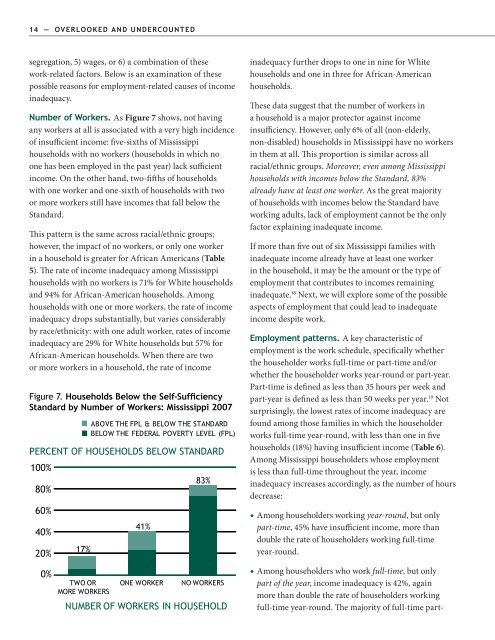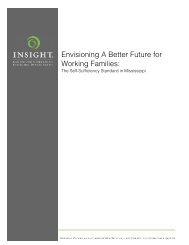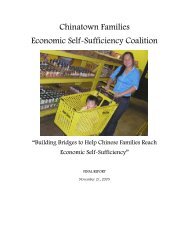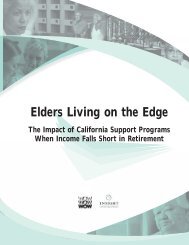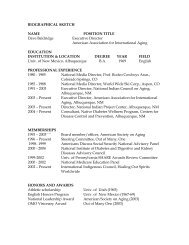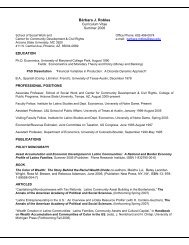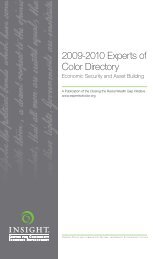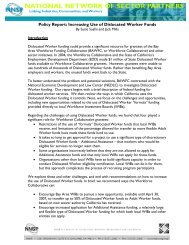Overlooked and Undercounted - Insight Center for Community ...
Overlooked and Undercounted - Insight Center for Community ...
Overlooked and Undercounted - Insight Center for Community ...
You also want an ePaper? Increase the reach of your titles
YUMPU automatically turns print PDFs into web optimized ePapers that Google loves.
14 — OVERLOOKED AND UNDERCOUNTED<br />
segregation, 5) wages, or 6) a combination of these<br />
work-related factors. Below is an examination of these<br />
possible reasons <strong>for</strong> employment-related causes of income<br />
inadequacy.<br />
Number of Workers. As Figure 7 shows, not having<br />
any workers at all is associated with a very high incidence<br />
of insufficient income: five-sixths of Mississippi<br />
households with no workers (households in which no<br />
one has been employed in the past year) lack sufficient<br />
income. On the other h<strong>and</strong>, two-fifths of households<br />
with one worker <strong>and</strong> one-sixth of households with two<br />
or more workers still have incomes that fall below the<br />
St<strong>and</strong>ard.<br />
This pattern is the same across racial/ethnic groups;<br />
however, the impact of no workers, or only one worker<br />
in a household is greater <strong>for</strong> African Americans (Table<br />
5). The rate of income inadequacy among Mississippi<br />
households with no workers is 71% <strong>for</strong> White households<br />
<strong>and</strong> 94% <strong>for</strong> African-American households. Among<br />
households with one or more workers, the rate of income<br />
inadequacy drops substantially, but varies considerably<br />
by race/ethnicity: with one adult worker, rates of income<br />
inadequacy are 29% <strong>for</strong> White households but 57% <strong>for</strong><br />
African-American households. When there are two<br />
or more workers in a household, the rate of income<br />
Figure 7. Households Below the Self-Sufficiency<br />
St<strong>and</strong>ard by Number of Workers: Mississippi 2007<br />
80%<br />
60%<br />
40%<br />
20%<br />
0%<br />
TWO OR<br />
MORE WORKERS<br />
ABOVE THE FPL & BELOW THE STANDARD<br />
BELOW THE FEDERAL POVERTY LEVEL (FPL)<br />
PERCENT OF HOUSEHOLDS BELOW STANDARD<br />
100%<br />
17%<br />
41%<br />
ONE WORKER<br />
83%<br />
NO WORKERS<br />
NUMBER OF WORKERS IN HOUSEHOLD<br />
inadequacy further drops to one in nine <strong>for</strong> White<br />
households <strong>and</strong> one in three <strong>for</strong> African-American<br />
households.<br />
These data suggest that the number of workers in<br />
a household is a major protector against income<br />
insufficiency. However, only 6% of all (non-elderly,<br />
non-disabled) households in Mississippi have no workers<br />
in them at all. This proportion is similar across all<br />
racial/ethnic groups. Moreover, even among Mississippi<br />
households with incomes below the St<strong>and</strong>ard, 83%<br />
already have at least one worker. As the great majority<br />
of households with incomes below the St<strong>and</strong>ard have<br />
working adults, lack of employment cannot be the only<br />
factor explaining inadequate income.<br />
If more than five out of six Mississippi families with<br />
inadequate income already have at least one worker<br />
in the household, it may be the amount or the type of<br />
employment that contributes to incomes remaining<br />
inadequate. 18 Next, we will explore some of the possible<br />
aspects of employment that could lead to inadequate<br />
income despite work.<br />
Employment patterns. A key characteristic of<br />
employment is the work schedule, specifically whether<br />
the householder works full-time or part-time <strong>and</strong>/or<br />
whether the householder works year-round or part-year.<br />
Part-time is defined as less than 35 hours per week <strong>and</strong><br />
part-year is defined as less than 50 weeks per year. 19 Not<br />
surprisingly, the lowest rates of income inadequacy are<br />
found among those families in which the householder<br />
works full-time year-round, with less than one in five<br />
households (18%) having insufficient income (Table 6).<br />
Among Mississippi householders whose employment<br />
is less than full-time throughout the year, income<br />
inadequacy increases accordingly, as the number of hours<br />
decrease:<br />
Among householders working year-round, but only<br />
part-time, 45% have insufficient income, more than<br />
double the rate of householders working full-time<br />
year-round.<br />
Among householders who work full-time, but only<br />
part of the year, income inadequacy is 42%, again<br />
more than double the rate of householders working<br />
full-time year-round. The majority of full-time part-


